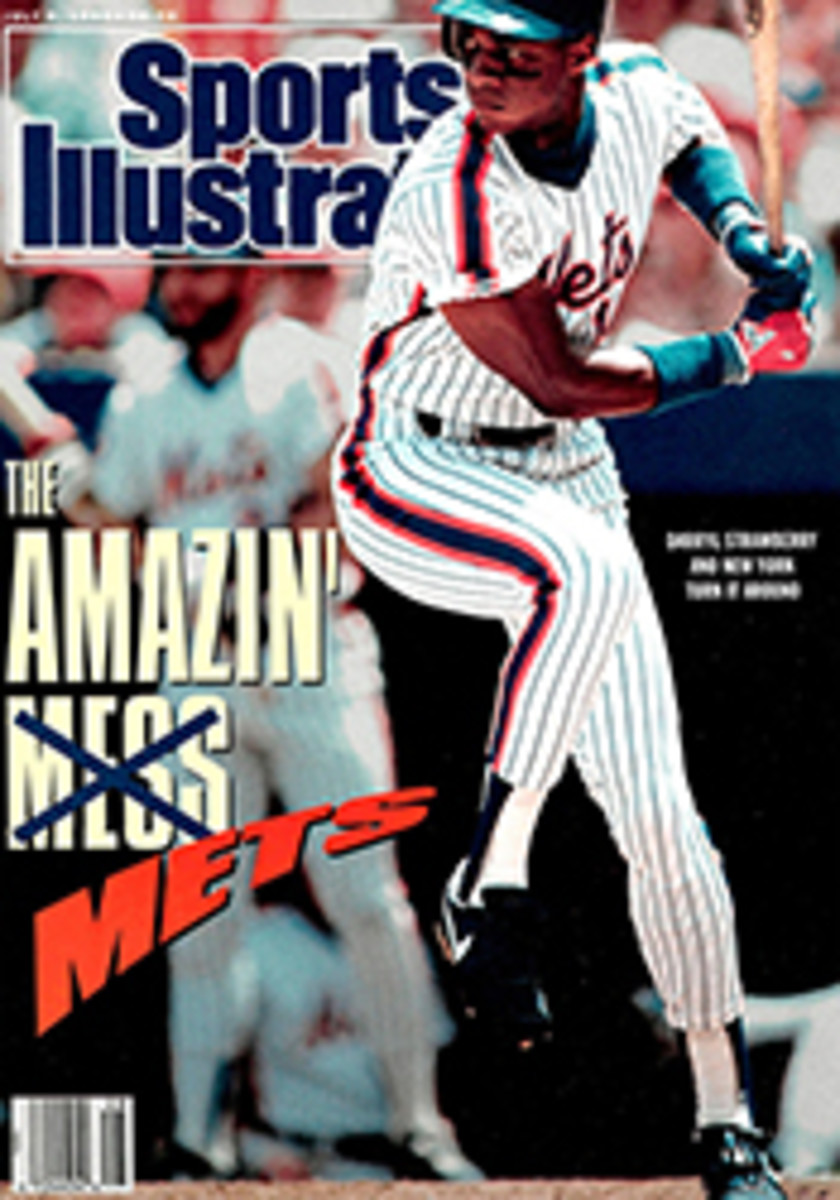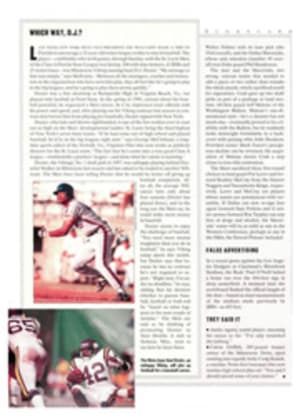
SCORECARD
PICKING AND CHOOSING
"This is an embarrassment for golf," said a PGA of America official last week. He was referring to the fact that the club hosting this August's PGA Championship, the Shoal Creek Country Club in Birmingham, has no black members and—worse—seems unreceptive to even the idea of having black members. "That's just not done in Birmingham," Shoal Creek founder Hall Thompson said when asked about accepting blacks into the all-white club. He added that "the country club is our home, and we pick and choose whom we want." Thompson later said he was sorry he had made the remarks, but he did not retract them.
Discrimination by private golf clubs is a complex subject. In effect, most country clubs discriminate; they invite only certain hand-picked individuals to join, and turn away everyone else. Even though few clubs have written policies barring specific groups (e.g., blacks, women, Jews and Hispanics) from membership, many—if not most-clubs remain male, white bastions, sometimes because of unwritten discriminatory policies, sometimes because the members simply don't have any close friends of different colors or religions to invite in as members. In some cities and states, private clubs are legally barred from discriminating, but the laws vary. For example, some pertain only to clubs of a certain size, some only to clubs that are regularly used for business purposes.
In selecting the site for its annual championship, the PGA of America (an organization of club pros that is separate from the PGA Tour) has generally dodged the discrimination issue and based its choice primarily on the quality of a course. The USGA, it should be noted, operates the same way in choosing a site for the U.S. Open, as do most other golf organizations that hold championships at a different site each year. "From our standpoint, if you set a policy against those private clubs [that do discriminate], it would significantly narrow down the number of clubs available at which to hold the tournament," says Jim Awtrey, the PGA of America's executive director and chief executive officer.
Besides being a sad comment on the extent of discrimination that exists, those words understate the potential influence of the PGA, the USGA and the PGA Tour. These bodies could do a lot to combat discrimination—and, incidentally, save themselves from future Shoal Creek-type "embarrassments"—if they declared that in considering tournament sites, they would favor clubs that have outstanding courses and open-minded membership policies.
CONCRETE ACHIEVEMENT
The event was billed as "a unique look at the country's future engineering leaders," and unique it was. The third annual National Concrete Canoe Competition, staged two weeks ago in Amherst, N.Y., by the American Society of Civil Engineers, brought together engineering students from 19 colleges for two days of racing—and scientifically explaining the buoyancy of—the two-person concrete canoes they had built.
"If you think about it, concrete is seven times lighter than steel, and steel is what they make barges out of," said Michigan State senior David Jeakle, copaddler for the Spartan men (each school was represented by a men's boat, a women's boat and a coed boat). "You pretty much know it's going to float. What you worry about is whether the bottom is strong enough that you don't crack it when you kneel."
Though the canoes weighed an average of 175 pounds (down from an elephantine 300 last year), none sank, and only one, from the City College of New York, suffered significant cracking. The vessels earned points for design, construction, speed and maneuverability; 60% of each team's score was based on oral and written presentations, 40% on sprint and distance races. The paddles, by the way, were made of fiberglass, not concrete.
When all the points were tallied, Jeakle and his Michigan State teammates had edged Maryland for first place, thereby winning $5,000 in scholarship money for their school's civil engineering department. While Michigan State claimed to have trained harder than other teams, the Spartans also may have benefited from the lightness of their boat, a 109-pound, shiny-hulled beauty named the Rowing Stone.
BEATING THE DRAFT
SI's Jack McCallum reports on last week's NBA draft.
As Golden State coach Don Nelson put it, this draft was deep but had a "lack of greatness" about it. Indeed, with no gifted naval officers or tongue-wagging slam-dunk artists or foreign-born franchise centers up for grabs, the teams that emerged as the clearest winners were two that remained quiet while the choices were being made: the Utah Jazz, which chose 7'1" Dartmouth center Walter Palmer with its lone pick (the 33rd overall), and the Dallas Mavericks, whose only selection (number 49 overall) was Duke guard Phil Henderson.
The Jazz and the Mavericks, two strong, veteran teams that needed to add a piece or two rather than remake the whole puzzle, wisely sacrificed youth for experience. Utah gave up two draft picks as part of a package to land two-time All-Star guard Jeff Malone of the Washington Bullets. Malone's one-dimensional style—he's a shooter but not much else—eventually proved to be a liability with the Bullets, but he suddenly looks downright formidable in a back-court with passing whiz John Stockton. Provided center Mark Eaton's precipitous decline can be reversed, the acquisition of Malone moves Utah a step closer to true title contention.
The Mavs sacrificed three first-round choices to land guard Fat Lever and forward Rodney McCray from the Denver Nuggets and Sacramento Kings, respectively. Lever and McCray are players whose names are synonymous with versatility. If Dallas can now re-sign free agent forward Sam Perkins and if center-power forward Roy Tarpley can stay free of drugs and alcohol, the Mavericks' roster will be as solid as any in the Western Conference, perhaps as any in the NBA, the Detroit Pistons' included.
FALSE ADVERTISING
In a recent game against the Los Angeles Dodgers at Cincinnati's Riverfront Stadium, the Reds' Paul O'Neill belted a home run over the 404-foot sign in deep centerfield. A moment later the scoreboard flashed the official length of the shot—based on exact measurements of the stadium made previously by IBM-as 403 feet.
WHICH WAY, D.J.?
Last week New York Mets vice-president Joe McIlvaine made a trip to Florida to encourage a 24-year-old minor league rookie to stay in baseball. The player—a leftfielder who in 68 games, through Sunday, with the St. Lucie Mets of the Class A Florida State League was hitting .308 with nine homers, 42 RBIs and 25 stolen bases—was Minnesota Viking running back D.J. Dozier. "My message to him was simple," says McIlvaine. "Between all the managers, coaches and instructors in the organization who have seen him play, they all feel like he's going to play in the big leagues, and he's going to play there pretty quickly."
Dozier was a fine shortstop at Kempsville High in Virginia Beach, Va., but played only football at Penn State. In the spring of 1989, curious about his baseball potential, he requested a Mets tryout. In it he impressed team officials with his power and speed, and, after playing out his Viking contract last season (a contract that barred him from playing pro baseball), Dozier signed with New York.
Dozier, who bats and throws righthanded, is one of the few rookies ever to start out so high on the Mets' developmental ladder, St. Lucie being the third-highest of New York's seven farm teams. "If he had come out of high school and played baseball, he'd be in the big leagues right now," says George McClelland, a longtime sports editor of the Norfolk, Va., Virginian-Pilot who now works as publicity director for the St. Lucie team. "The fact that he's come into a very good Class A league—traditionally a pitchers' league—and done what he's done is stunning."
Dozier, the Vikings' No. 1 draft pick in 1987, was unhappy playing behind Herschel Walker in Minnesota last season and has asked to be traded to another NFL team. The Mets have been telling Dozier that he would be better off giving up football completely. After all, the average NFL career lasts only about four seasons (Dozier has played three), and in the long run, the Mets say, he could make more money in baseball.
Dozier seems to enjoy the challenge of baseball. "You need more mental toughness than you do in football," he says. Viking camp opens this month, but Dozier says that because he has no contract he's not required to report. "Right now, I'm under no deadline," he says, adding that his decision whether to pursue baseball, football or both will be "based on what happens in the next couple of months." The Mets are said to be thinking of promoting Dozier to their Double A club in Jackson, Miss., soon to see how he fares there.
ILLUSTRATION
PATRICK MCDONNELL
PHOTO
TOM DIPACE
The Mets hope that Dozier, an unhappy Viking, will give up football for a baseball career.
PHOTO
FOCUS ON SPORTS
[See caption above.]
THEY SAID IT
•Andre Agassi, tennis player, assessing his career so far: "I've only scratched the iceberg."
•Calvin Griffith, 285-pound former owner of the Minnesota Twins, upon running into equally hefty Craig Kusick, a onetime Twins first baseman who now teaches high school phys ed: "You and I should attend some of your classes."

